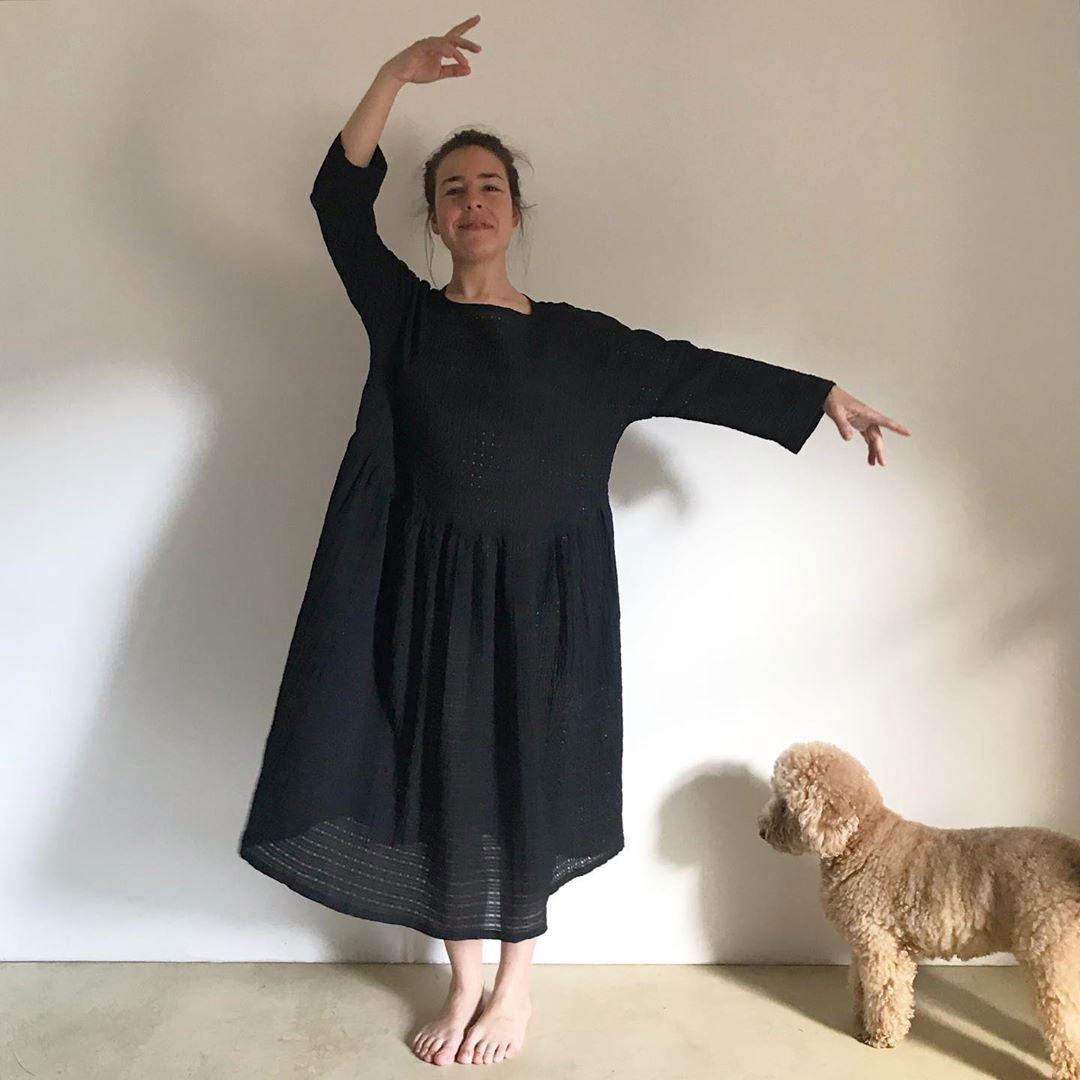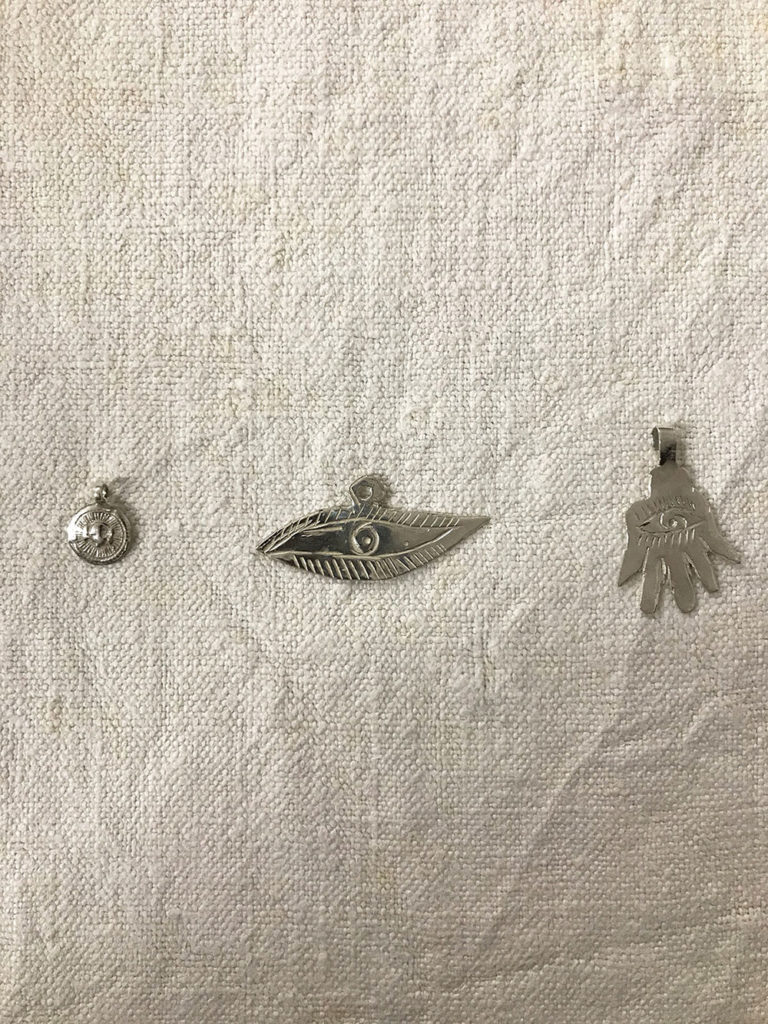Jaime (Mallorca) was interviewed on the phone by Igor (Madrid) in March 2020.
Igor took these portraits of Jaime at what used to be his flat in Madrid, in January 2019.
The rest of images that illustrate this article are courtesy of J. Llambias.
Now based in Mallorca, where he’s originally from, I met Jaime through a mutual friend when he lived in Madrid. Back then, Jaime was starting his fashion label, J. Llambias, and had just launched his first collection, composed of oversized shirt dresses with hand-picked buttons, linen and cotton trousers, and some incredible mohair jumpers in earthy tones and a vibrant red.
I hadn’t chatted with Jaime in a while, but I had been following his updates on his Instagram profile; where he shares his fabric finds, dyeing experiments and everything else we, as customers, should know about what’s behind a fashion brand.
That’s why when I started thinking about this project, Jaime was one of the first people that came to my mind. I told him about it, and called him on the 5th day of quarantine in Spain due to COVID-19. This is the conversation we had.
We’re in the first week of quarantine, what are you currently wearing?
I’m wearing my pyjamas [laughs]. Although, I just tried on a dress I finished sewing in the past few days, in order to see how it fits and its movement. It’s something I always do. I’m not too tall and I’m quite skinny, and most of my pieces are oversized so I try them on.
Some people are recommending we continue our routines, dressing as usual even though we have to stay at home. You’re clearly not following this advice?
I live in the countryside in Mallorca and there are no neighbours around. I’m currently here with my sister and we’ve talked about how easy it is to wear your pyjamas all day long. We need to smarten up a little bit — even if it’s just a pair of jeans and a shirt to make this situation more enjoyable.
I think I’m the worst customer ever so I can’t really think of myself as a customer when I’m designing something.
I remember you once told me something along the lines of you not being really interested in buying clothes. Is this true?
It is. I think I’m the worst customer ever so I can’t really think of myself as a customer when I’m designing something. I barely buy anything and, when I do, it’s stuff I don’t actually need.
I try to create pieces that can be enjoyed, but there has to be a need behind them. For example, every time I design a dress, I think that someone has to need it.
What do you mean by ‘need’ here?
I’d love to create a series of pieces that people can use in their day-to-day lives, although I don’t want to use the word ‘basics’ because I don’t like it. It’s difficult to explain.
I understand. For example, I have some pieces that aren’t what you’d call ‘basics’, but I use them on a weekly basis because I’m comfortable wearing them, they fit me, they’re versatile in terms of mixing them with other pieces…
Exactly. It’s about creating pieces that make you happy and that you need for certain occasions. For example, I finished a black dress that my sister has just tried on, and it’s a piece I can picture lots of my clients wearing.
Is it easy to define your clients or are they quite different from each other?
They’re quite different, but I’m trying to direct my brand towards a type of client who understands the lifestyle I want to convey with it: a way of doing things, buying, dressing… I’m not sure I can currently communicate this fully with my brand, but I’d like to get there.
Most people don’t understand why a dress can cost up to €180 when they can get one at Zara for €40.
Do you think people are more aware now about what running a small fashion brand entails?
I don’t think so — at least a big percentage of people are not aware. There are some, but it’s not enough. Most people don’t understand why a dress can cost up to €180 when they can get one at Zara for €40 1. This isn’t explained anywhere
I believe that when you buy something from a small brand, there’s this interest in finding out more about who’s behind it and its universe.
I think this is really important but you have to provide this information in bite sizes, so people understand it — the brand has to have a very defined identity. Customers want to see that universe on your Instagram profile, your website, everywhere… from how you pack your parcels before shipping the pieces to how you make your clothes. They want to know everything.
And if there’s someone behind the label, they also want to know about this. I try not to reveal much about myself at the moment, but maybe this is something I have to work on in the future.
I guess this is something that has started to happen pretty recently with the growth of Instagram, influencer culture and the need of showing what we do constantly. It’s quite interesting and Jacquemus 2 is a good example.
In his case, I don’t think it’s only him behind the brand, but also the whole universe he’s created. One of my friends got married recently and bought one of his suits. When it arrived, it came with that universe: the beach, the Mediterranean sea and everything around it…
I would prefer to define my universe completely and then, if it’s necessary afterwards, tell a little bit more about myself.
I think my parents’ friends and acquaintances could be my ideal clients — all those people I used to observe when I was a kid and that I would like to dress now.
What’s your universe?
Both of my parents are artists and, since I was little, I’ve been surrounded by other artists, gallerists… I think my parents’ friends and acquaintances could be my ideal clients — all those people I used to observe when I was a kid and that I would like to dress now.
Those women shared attitudes and interests; I would stare at them while they smoked, drank their gin & tonics or packed their suitcases to attend Art Basel 3. When I’m designing some of my pieces, I look back at some of those women and think that they could wear them.
You’ve recently moved back to Mallorca; I guess everything is more peaceful there and you have more time to get inspired. Although, most of the fashion industry in Spain is based in Madrid. How does this influence your brand?
At the moment, I’m very happy to be here and not in a big city. I’m still in touch with people from the fashion world in Madrid, Paris and other cities because I need to. But I love staying at home, working at my own workshop where I design, choose fabrics, sew the prototypes…
I like creating things here and taking them to other places. I think it’s something very positive for the brand and people in the industry appreciate it.
I find going to flea markets very relaxing and it’s one of the happiest moments in my week.

Regarding fabrics choice, on your Instagram account you share a lot of content related to this. You usually go to flea markets and find fabrics there that are really old. Can you tell me a little bit more about this?
I’ve always loved flea markets and everything they entail: the people selling there, bargaining for things… I find it very relaxing and it’s one of the happiest moments in my week. I go to flea markets in Palma de Mallorca but also when I travel — I’ve bought fabrics and many other things in Lisbon, Madrid, Barcelona, Paris or London.
Here in Palma, there’s a market happening every Sunday, and it’s like a ritual for me and one of the places where I draw most of my inspiration from. The quality of the fabrics you can find is amazing: cotton, linen or wool made many years ago. For example, just recently, I bought a fabric that is 170 years old.
How do you find out about this? Is it through the sellers?
Yes, in Mallorca there’s this fabric called ‘drap’ — it’s similar to linen and was used to make bedding, curtains, skirts… In many houses here, you can still find lots of this type of fabric stored.
There are women who collect it from these houses and then sell it. It’s a natural fabric in perfect condition that can be sold per metre, or has been transformed into bedsheets and other types of bedding. There’s still a lot of it, you just have to pass by one of the stalls where it’s sold at the flea market and pay attention.
So you use this type of fabric to create limited edition pieces.
Somehow! I’m starting to sell some of these pieces on my website and I’m presenting them as unique pieces, as they’re not part of the main collection. The most important thing is that these fabrics fit the brand and the universe I’m trying to create, so these ‘limited edition’ pieces can make sense with the rest of items.
Lots of designers are currently upcycling, using vintage clothing, but this is another route and I find it really interesting. You’re also adding some storytelling to the pieces you create, and you’re doing this right now through your Instagram profile. How are you going to tell this when selling your products?
It’s definitely more difficult at a brick-and-mortar store but, for example, my stockist in Madrid, Mott 4, knows about the stories behind the pieces and can tell them to its clients. This is something I already do on my website — I tell a little bit about the origins of the different fabrics and about each piece.
I wish everyone would be interested in finding out more about where the pieces they buy come from. But I understand that this is something that might not be appealing to everyone.
There are also some people that are a little picky when it comes to wearing ‘old’ fabrics. Say you use a 120-year-old fabric that has been dyed and washed — some people aren’t interested in it, and I understand that and accept it. It’s about finding those people who can appreciate it. I prefer to sell less and better.
I’m currently dyeing a 150-year-old linen fabric using avocado shells and pits at my countryside house, what’s more sustainable than this?
Let’s talk about sustainability. Almost every small brand is more sustainable than bigger labels, but I’d like you to tell me how J. Llambias contributes towards this.
I’m currently dyeing a 150-year-old linen fabric using avocado shells and pits at my countryside house, what’s more sustainable than this? [laughs]
There’s a lot of ‘greenwashing’ 6 currently, and every single brand wants to jump on the bandwagon.
I’ve never meant to run a sustainable brand — I guess this is something that happens organically, although I don’t think my label is 100% sustainable. But I do believe that everything I do is based around these principles.
You have to be true to yourself, so you can create a beautiful product that reflects your values.

I’ve been thinking a lot during the quarantine. We’ve stayed at home for almost a week now, and we still don’t know for how much longer we’re going to have to stay in. I believe this is an opportunity to value what we already have, and I think this might have an impact in the way we consume things in the future 7. What do you think about this?
It’s going to affect our habits, definitely. We were in a toxic cycle and I think people are going to realise this if we end up being on lockdown for a long time. It’s complicated, and there’s space for different types of consumption, but our habits should change.
You have to be true to yourself, so you can create a beautiful product that reflects your values.
Over the past few years, there’s been lots of chat about the fast-paced rhythm of the fashion industry in terms of collections, runway shows…
I wish this would also change. I’ve tried to do things differently, but it’s impossible. Either you have some additional income, or you can’t do it because the fairs and shops still follow this calendar, as well as the customers.
Can it be changed? Of course. Is this something that benefits the key players in the industry? No
Change must come from customers, but it’s very difficult. They need to move from thinking about needing something from a collection or a trend to being interested in building up a wardrobe made of ‘permanent’ pieces.
It could happen. We’re currently going through one of the most shocking things we’ll probably see in our lifetime and this is going to have a big impact. Let’s see what happens.
1. According to The Guardian, the average use of a fast fashion dress is 5 weeks.
2. Simon Porte Jacquemus started his own brand when he was just 19 years old and many publications have named him “Instagram’s favourite designer”.
3. Art Basel Hong Kong 2020 was cancelled due to COVID-19 and replaced by online viewing rooms. Art Basel’s June edition has been postponed to September 2020.
4. Located in the Justicia neighbourhood, Mott stocks a nicely curated selection of womenswear brands with a focus on sustainability.
5. Dyeing with avocado pits results in a soft pink tone, or millennial pink according to The New York Times.
6. The term ‘greenwashing’ originated in 1986 in an essay written by American environmentalist Jay Westerveld.
7. In one of the latest editions of The Business of Fashion Podcast, aired just after recording this interview, Vogue Italia Editor-in-Chief Emanuele Farneti asks “Do we still need to buy more clothes?”.









